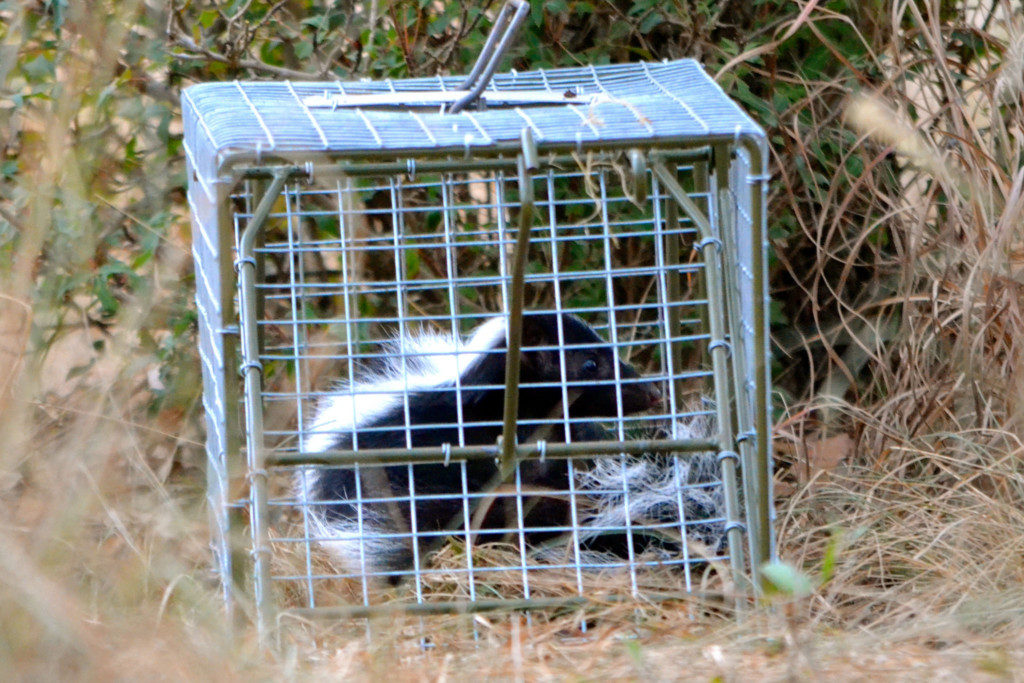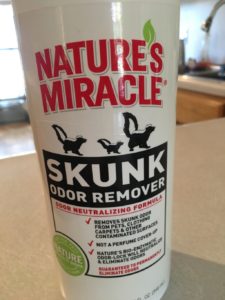This post was collaboratively written with my husband, Ron Soos. I promised I’d give credit.
If you have lived in South Texas long, you’ve likely encountered them: furry, black and white, kinda cute, nocturnal, and threatening of a terrible, terrible smell.
Despite the fact that a skunk’s scent is literally designed by God to be an exceptionally effective deterrent, the furry canine idiot we live with thinks a skunk would be the ultimate best friend. This means that over the past few years, we’ve had more skunk encounters than we would like and been forced to become experts on both smell removal and skunk relocation. It also means that apparently our fluffy-faced friend simply. cannot. learn.

We’ve dealt with the ol’ he-found-a-carcass-somewhere-and-rolled-in-it smell. And we’ve handled the he-got-close-enough-to-get-misted-by-some-spray smell. But we’ve also had some doozies. Like the time we were walking him on a leash and he still broke away to chase a skunk…which he caught by the tail…which came clean off in his mouth.
Let me repeat that for emphasis: A skunk’s tail. Came off. In my dog’s mouth.
You can’t begin to imagine the intense toxicity of that kind of smell. It is nothing like the skunk smell you encounter when you pass their little bodies on the side of the road. No. When that concentration of oil gets sprayed directly into your dog’s face, it smells like chemical warfare. I nearly vomited on the spot. I’ve never encountered anything like it. Our dog’s eyes were watering and red, his mouth was foaming—he was clearly in distress. I called our vet (my dad), and he gave us first aid instructions and advised that our dog would most likely get sick so we should be sure to “keep him outside for quite awhile.” Um, no problem, I thought. He’s never going to be allowed in the house again. He smells like a bio-hazard dump.
Miraculously, there was no permanent damage done to his eyes, and he did not get sick (that we witnessed). Once we knew he was OK, I secretly rejoiced that this skunk encounter had been so traumatic. Surely he would learn his lesson this time and avoid skunks for the rest of his life. Right?
Not long after the tail incident, the same dog, still smelling of skunk, cornered another one on our back deck very early one morning. The skunk sprayed the house in its attempt to get away. While I was grateful the dog didn’t take a direct hit this time, we still spent an entire Tuesday morning in full cover and gloves, on ladders, bleaching most of the back of our house and deck. Not kidding.
We realized while sanitizing our back window screens that there must be a skunk den under the deck. Why else would we have such frequent skunk encounters? We had to get rid of it. Or surrender to living with that smell forever. The latter was not an option for me. So, my husband made a few calls about services that might help out. No luck. We were told either “don’t bother—trapping doesn’t work” or “sure, we’ll help you out for roughly one million dollars.”
Our situation was clinched when my father-in-law said, “Ain’t no way you are catchin’ a skunk. They’re way too smart!” My husband heard this and interpreted it as a direct challenge. We were now in the business of skunk trapping.
For the next week or so, we followed a variety of instructions. We bought a humane Have-A-Heart trap. We studied. We Googled. We put out the trap and tried all the recommended bait: cat food, marshmallows, sardines, hot dogs, bacon, peanut butter, etc. Nothing worked. Oh, we caught things: several cats, a possum, a few raccoons, even a neighbor kid snooping around one night. But, no skunks.
Then, one night, we feasted on some delicious Copper River salmon that our dear friends in Seattle had sweetly sent us. (By the way, if you haven’t ever had any, do so at your next opportunity. It puts all other salmon to shame and is difficult to get due to its very, very short season.) Anyway, I had read that skunks like fish, so despite how difficult it was to leave some as leftovers, we set aside some wild-caught Copper River salmon for the skunk-trapping project.
The next morning, while still dark, searching with a flashlight from the deck, we checked the trap and—behold!—a flicker of black and white movement. A SKUNK! It had worked! We finally had our unwanted resident in the trap. One problem solved.
Aaaand a new problem began. Now what?

Surely, now that the animal was already trapped, someone from the Texas Parks & Wildlife Department or animal control would help.
But, um, no. No, they would not. (Well, in all fairness, one company agreed to remove the skunk…for hundreds and hundreds and hundreds of dollars. No thanks.)
Back to Google.
We finally found a recommended method described in detail for how to remove a skunk from a trap. For your reading enjoyment, I will relay this important information to you here:
First, cover all the things. As if you yourself are going into actual chemical warfare. Layer up in clothes you can throw away, if needed, and duct tape all seams and openings. If you look like you are going to the moon in a homemade spaceship, then you have done it correctly. Second, find a large sheet—large enough to hide behind—that you can also throw away, if needed. And then—I’m not making this up—more than one resource, including Texas Parks & Wildlife, suggests that you then “consider humming a pleasant tune while you do the task” to help the skunk remain calm. This was going to be a riot.
I vividly remember looking out my kitchen window later that morning, and there was my daring husband, dressed as the Michelin Man, hiding behind a floral sheet, slinking slowly across our yard, singing “Kiss On My List” by Hall & Oates as he made his way cautiously toward the skunk in the cage.
According to the experts, a skunk is not likely to spray if it cannot locate its predator. So, once the cage is covered, the skunk is calm and doesn’t feel threatened. It certainly doesn’t want to spray itself. The now floral-covered cage was transported to the bed of my husband’s truck, and together, he and the skunk set off to find a new home. (FYI, it is legal in Texas to relocate a skunk to any public land, including highway easements. Parks & Wildlife recommends a wooded area with easy access to water.) My husband drove it far away from our house, near a river, and then completed the instructions in reverse: gently remove covered cage from truck, face the opening of the cage away from you, open the door to the cage, gently remove the sheet as you back away—again, while humming a pleasant tune—and after a few moments, the skunk will be on its way to find new friends. And so it was.
And yes, ever since then, my husband has been known as The Skunk Whisperer. And we tore up that deck and poured concrete, because no one wanted to go through this again!
For those times when you are unable to serenade your skunk to relocation and your dog ends up sprayed, here are our best tips:
- We have certainly used some of the home recipes (the most recommended one is below), but we also make a habit now of always having this shampoo on hand, as it is very effective.
- Skunk spray is mostly oil, so think about that when you are trying to get rid of it. Plain water won’t touch it. (In fact, in the days/weeks to come you’ll notice that anytime your dog gets wet, the smell will reactivate again. You will likely notice the faint stench of skunk for months to come.)
- Whether you use the store-bought shampoo or the homemade recipe, BE SURE TO LET IT SOAK ON YOUR DOG for as long as your dog will allow before rinsing. The longer you let the soap sit, the more oil will break down and be removed when you rinse.

We’ve been through enough skunk encounters with our dog that we have cultivated our own official skunk-spray removal routine. It includes the following:
- A good, thorough soaking in water, to make sure all of our dog’s hair is wet. (Don’t forget collars, leashes, and other things that might have also been sprayed.)
- Plenty of soap/shampoo lathered for many, many minutes.
- AMPLE TIME FOR SOAP TO SOAK ON THE FUR. We wait as close to 10 minutes as our dog will tolerate.
- Repeat.
- And sometimes, repeat again.
And here is a recipe for skunk shampoo that you can make from products you have at home, just in case your dog gets sprayed in the wee hours of morning and you happen to need it:
Homemade Skunk Shampoo
recommended by both the Humane Society and my dad
1 quart of 3% hydrogen peroxide (available at most pharmacies)
1/2 c. baking soda
1 tsp. liquid dishwashing soap
Good luck out there!











